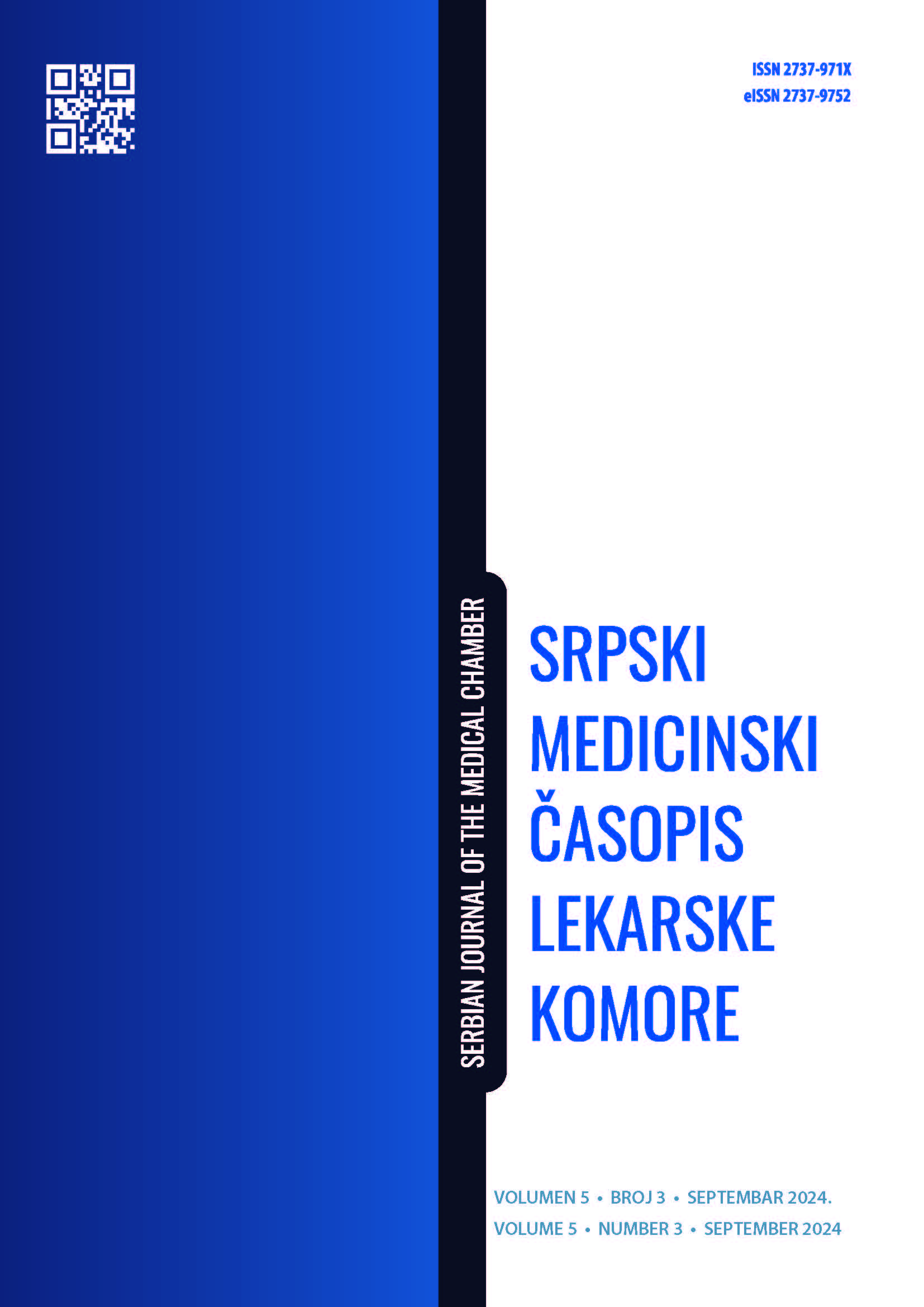FREQUENCY AND SIGNIFICANCE OF THE DEVELOPMENT OF FEBRILE NEUTROPENIA IN PATIENTS WITH HEMATOLOGICAL MALIGNANCIES TREATED IN THE DAY-CARE UNIT OF A TERTIARY INSTITUTION
Abstract
Introduction: Chemotherapy-induced neutropenia is often complicated by the development of febrile neutropenia (FN) which is associated with infections, dose reductions/delay of chemotherapy, quality of life deterioration, and increased treatment costs.
Aims: The study aims to research the association between risk factors for FN and the significance of applying G-CSF in patients with hematological malignancies.
Methods: We evaluated 90 patients with lymphoma, multiple myeloma (MM), and myelodysplastic syndrome (MDS) treated at the Day-care Unit of the University Clinical Center of Serbia (UCCS) Clinic for Hematology, between January and June 2024.
Results: The study included 90 patients with the following diagnoses: 70 (77.8%) patients with lymphomas, 12 (13.3%) patients with MM, and 8 (8.9%) patients with MDS, of whom 42.2% (38/90) male and 57.8% (52/90) female. Febrile neutropenia (FN) was observed in 22 (24.4%) patients, while 68 (75.6%) patients did not develop FN. The distribution of FN by lymphoma type was as follows: 57.9% in aggressive lymphomas, 31.6% in indolent lymphomas, and 10.5% in Hodgkin's lymphoma. FN was associated with a higher incidence of advanced clinical stages of disease, with 70% in stages III and IV. Patients with FN had significantly higher rates of bulky tumor mass (54.5% vs. 25%; p = 0.010), more lines of chemotherapy (p = 0.020), more cycles of chemotherapy (p = 0.027), more immunotherapy cycles (p = 0.025), as well as more infections (59.1% vs. 27.9%; p = 0.008), antibiotic use (95.5% vs. 33.8%; p = 0.004), and G-CSF administration (54.5% vs. 11.8%; p < 0.001), with more G-CSF ampoules used (5.0 vs. 1.0; p < 0.001). Higher CRP levels were also significantly associated with FN (7.2% vs. 3.3%; p = 0.012).
Conclusion: Our study has shown that the number of lines of therapy, the number of immunochemotherapy cycles, the clinical stage, the presence of bulky tumor mass, and the aggressiveness of the lymphoma affected FN development.
References
Moreau M, Klastersky J, Schwarzbold A, Muanza F, Georgala A, Aoun M, et al. A general chemotherapy myelotoxicity score to predict febrile neutropenia in hematological malignancies. Ann Oncol. 2009 Mar;20(3):513-9. doi: 10.1093/annonc/mdn655.
Thursky KA, Worth LJ. Can mortality of cancer patients with fever and neutropenia be improved? Curr Opin Infect Dis. 2015 Dec;28(6):505-13. doi: 10.1097/QCO.0000000000000202.
Crawford J, Dale DC, Lyman GH. Chemotherapy-induced neutropenia: risks, consequences, and new directions for its management. Cancer. 2004 Jan 15;100(2):228-37. doi: 10.1002/cncr.11882.
Lalami Y, Paesmans M, Muanza F, Barette M, Plehiers B, Dubreucq L, et al. Can we predict the duration of chemotherapy-induced neutropenia in febrile neutropenic patients, focusing on regimen-specific risk factors? A retrospective analysis. Ann Oncol. 2006 Mar;17(3):507-14. doi: 10.1093/annonc/mdj092.
Blay JY, Chauvin F, Le Cesne A, Anglaret B, Bouhour D, Lasset C, et al. Early lymphopenia after cytotoxic chemotherapy as a risk factor for febrile neutropenia. J Clin Oncol. 1996 Feb;14(2):636-43. doi: 10.1200/JCO.1996.14.2.636.
Crawford J, Dale DC, Lyman GH. Chemotherapy-induced neutropenia: risks, consequences, and new directions for its management. Cancer. 2004 Jan 15;100(2):228-37. doi: 10.1002/cncr.11882.
Silber JH, Fridman M, DiPaola RS, Erder MH, Pauly MV, Fox KR. First-cycle blood counts and subsequent neutropenia, dose reduction, or delay in early-stage breast cancer therapy. J Clin Oncol. 1998 Jul;16(7):2392-400. doi: 10.1200/JCO.1998.16.7.2392.
Kondo M, Oshita F, Kato Y, Yamada K, Nomura I, Noda K. Early monocytopenia after chemotherapy as a risk factor for neutropenia. Am J Clin Oncol. 1999 Feb;22(1):103-5. doi: 10.1097/00000421-199902000-00025.
Rolston KV. New trends in patient management: risk-based therapy for febrile patients with neutropenia. Clin Infect Dis. 1999 Sep;29(3):515-21. doi: 10.1086/598624.
Smith TJ, Bohlke K, Armitage JO. Recommendations for the use of white blood cell growth factors: American Society Of Clinical Oncology Clinical Practice Guideline Update. J Oncol Pract. 2015 Nov;11(6):511-3. doi: 10.1200/JOP.2015.006742.
Crawford J, Becker PS, Armitage JO, Blayney DW, Chavez J, Curtin P, et al. Myeloid growth factors, version 2.2017, NCCN Clinical Practice Guidelines in Oncology. J Natl Compr Canc Netw. 2017 Dec;15(12):1520-41. doi: 10.6004/jnccn.2017.0175.
Klastersky J, de Naurois J, Rolston K, Rapoport B, Maschmeyer G, Aapro M, et al.; ESMO Guidelines Committee. Management of febrile neutropaenia: ESMO Clinical Practice Guidelines. Ann Oncol. 2016 Sep;27(suppl 5):v111-8. doi: 10.1093/annonc/mdw325.
Martin WG, Ristow KM, Habermann TM, Colgan JP, Witzig TE, Ansell SM. Bleomycin pulmonary toxicity has a negative impact on the outcome of patients with Hodgkin’s lymphoma. J Clin Oncol. 2005 Oct 20;23(30):7614-20. doi: 10.1200/JCO.2005.02.7243.
Islas-Muñoz B, Volkow-Fernández P, Silva-Zamora J, Ramírez-Ibarguen A, Cornejo-Juárez P. Mortality in patients with hematological malignancies, febrile neutropenia, and septic shock. J Infect Dev Ctries. 2024 Feb 29;18(2):235-42. doi: 10.3855/jidc.17451.
Rivera E, Haim Erder M, Fridman M, Frye D, Hortobagyi GN. First-cycle absolute neutrophil count can be used to improve chemotherapy-dose delivery and reduce the risk of febrile neutropenia in patients receiving adjuvant therapy: a validation study. Breast Cancer Res. 2003;5(5):R114-20. doi: 10.1186/bcr618.
Silber JH, Fridman M, DiPaola RS, Erder MH, Pauly MV, Fox KR. First-cycle blood counts and subsequent neutropenia, dose reduction, or delay in early-stage breast cancer therapy. J Clin Oncol. 1998 Jul;16(7):2392-400. doi: 10.1200/JCO.1998.16.7.2392.
Wilson-Royalty M, Lawless G, Palmer C, Brown R. Predictors for chemotherapy-related severe or febrile neutropenia: a review of the clinical literature. J Oncol Pharm Pract. 2001 Dec;7(4):141-7. doi: 10.1191/1078155201jp084oa.
Ceken S, Gedik H, Iskender G, Demirelli M, Mert D, Yapar Toros G, et al. Evaluation of risk factors for mortality in febrile neutropenia. J Infect Dev Ctries. 2020 Aug 31;14(8):886-92. doi: 10.3855/jidc.12520.

